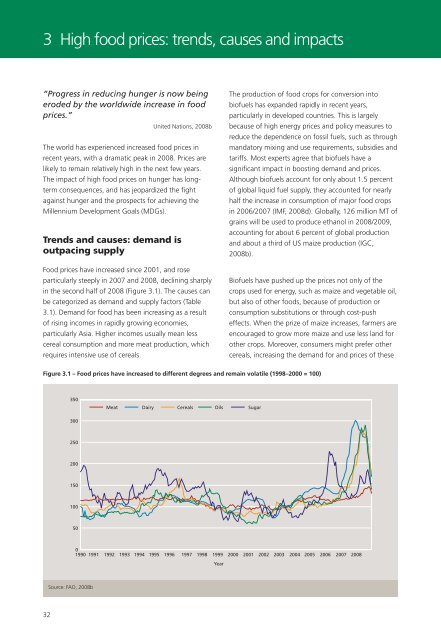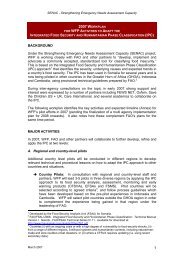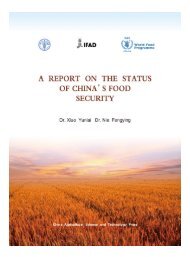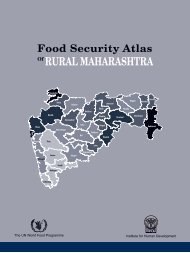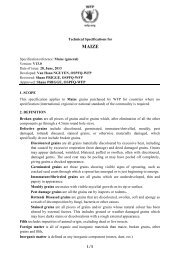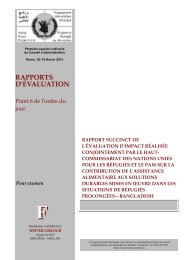World Hunger Series Hunger and Markets - WFP Remote Access ...
World Hunger Series Hunger and Markets - WFP Remote Access ...
World Hunger Series Hunger and Markets - WFP Remote Access ...
Create successful ePaper yourself
Turn your PDF publications into a flip-book with our unique Google optimized e-Paper software.
3 High food prices: trends, causes <strong>and</strong> impacts“Progress in reducing hunger is now beingeroded by the worldwide increase in foodprices.”United Nations, 2008bThe world has experienced increased food prices inrecent years, with a dramatic peak in 2008. Prices arelikely to remain relatively high in the next few years.The impact of high food prices on hunger has longtermconsequences, <strong>and</strong> has jeopardized the fightagainst hunger <strong>and</strong> the prospects for achieving theMillennium Development Goals (MDGs).Trends <strong>and</strong> causes: dem<strong>and</strong> isoutpacing supplyFood prices have increased since 2001, <strong>and</strong> roseparticularly steeply in 2007 <strong>and</strong> 2008, declining sharplyin the second half of 2008 (Figure 3.1). The causes canbe categorized as dem<strong>and</strong> <strong>and</strong> supply factors (Table3.1). Dem<strong>and</strong> for food has been increasing as a resultof rising incomes in rapidly growing economies,particularly Asia. Higher incomes usually mean lesscereal consumption <strong>and</strong> more meat production, whichrequires intensive use of cereals.The production of food crops for conversion intobiofuels has exp<strong>and</strong>ed rapidly in recent years,particularly in developed countries. This is largelybecause of high energy prices <strong>and</strong> policy measures toreduce the dependence on fossil fuels, such as throughm<strong>and</strong>atory mixing <strong>and</strong> use requirements, subsidies <strong>and</strong>tariffs. Most experts agree that biofuels have asignificant impact in boosting dem<strong>and</strong> <strong>and</strong> prices.Although biofuels account for only about 1.5 percentof global liquid fuel supply, they accounted for nearlyhalf the increase in consumption of major food cropsin 2006/2007 (IMF, 2008d). Globally, 126 million MT ofgrains will be used to produce ethanol in 2008/2009,accounting for about 6 percent of global production<strong>and</strong> about a third of US maize production (IGC,2008b).Biofuels have pushed up the prices not only of thecrops used for energy, such as maize <strong>and</strong> vegetable oil,but also of other foods, because of production orconsumption substitutions or through cost-pusheffects. When the prize of maize increases, farmers areencouraged to grow more maize <strong>and</strong> use less l<strong>and</strong> forother crops. Moreover, consumers might prefer othercereals, increasing the dem<strong>and</strong> for <strong>and</strong> prices of theseFigure 3.1 – Food prices have increased to different degrees <strong>and</strong> remain volatile (1998–2000 = 100)350Meat Dairy Cereals Oils Sugar3002502001501005001990 1991 1992 1993 1994 1995 1996 1997 1998 1999 2000 2001 2002 2003 2004 2005 2006 2007 2008YearSource: FAO, 2008b32


